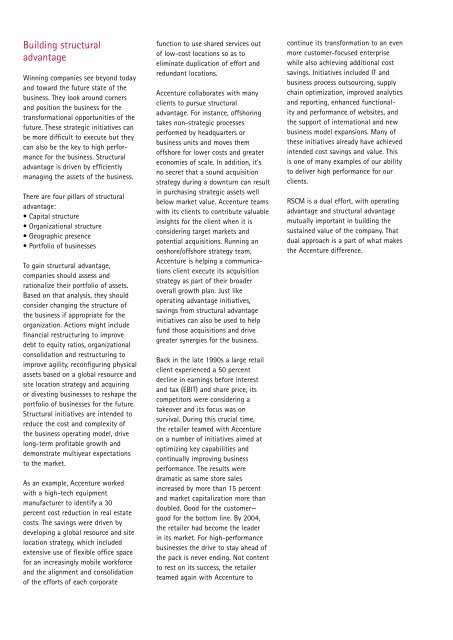Rapid and Sustained Cost Management
Rapid and Sustained Cost Management
Rapid and Sustained Cost Management
You also want an ePaper? Increase the reach of your titles
YUMPU automatically turns print PDFs into web optimized ePapers that Google loves.
Building structural<br />
advantage<br />
Winning companies see beyond today<br />
<strong>and</strong> toward the future state of the<br />
business. They look around corners<br />
<strong>and</strong> position the business for the<br />
transformational opportunities of the<br />
future. These strategic initiatives can<br />
be more difficult to execute but they<br />
can also be the key to high performance<br />
for the business. Structural<br />
advantage is driven by efficiently<br />
managing the assets of the business.<br />
There are four pillars of structural<br />
advantage:<br />
• Capital structure<br />
• Organizational structure<br />
• Geographic presence<br />
• Portfolio of businesses<br />
To gain structural advantage,<br />
companies should assess <strong>and</strong><br />
rationalize their portfolio of assets.<br />
Based on that analysis, they should<br />
consider changing the structure of<br />
the business if appropriate for the<br />
organization. Actions might include<br />
financial restructuring to improve<br />
debt to equity ratios, organizational<br />
consolidation <strong>and</strong> restructuring to<br />
improve agility, reconfiguring physical<br />
assets based on a global resource <strong>and</strong><br />
site location strategy <strong>and</strong> acquiring<br />
or divesting businesses to reshape the<br />
portfolio of businesses for the future.<br />
Structural initiatives are intended to<br />
reduce the cost <strong>and</strong> complexity of<br />
the business operating model, drive<br />
long-term profitable growth <strong>and</strong><br />
demonstrate multiyear expectations<br />
to the market.<br />
As an example, Accenture worked<br />
with a high-tech equipment<br />
manufacturer to identify a 30<br />
percent cost reduction in real estate<br />
costs. The savings were driven by<br />
developing a global resource <strong>and</strong> site<br />
location strategy, which included<br />
extensive use of flexible office space<br />
for an increasingly mobile workforce<br />
<strong>and</strong> the alignment <strong>and</strong> consolidation<br />
of the efforts of each corporate<br />
function to use shared services out<br />
of low-cost locations so as to<br />
eliminate duplication of effort <strong>and</strong><br />
redundant locations.<br />
Accenture collaborates with many<br />
clients to pursue structural<br />
advantage. For instance, offshoring<br />
takes non-strategic processes<br />
performed by headquarters or<br />
business units <strong>and</strong> moves them<br />
offshore for lower costs <strong>and</strong> greater<br />
economies of scale. In addition, it’s<br />
no secret that a sound acquisition<br />
strategy during a downturn can result<br />
in purchasing strategic assets well<br />
below market value. Accenture teams<br />
with its clients to contribute valuable<br />
insights for the client when it is<br />
considering target markets <strong>and</strong><br />
potential acquisitions. Running an<br />
onshore/offshore strategy team,<br />
Accenture is helping a communications<br />
client execute its acquisition<br />
strategy as part of their broader<br />
overall growth plan. Just like<br />
operating advantage initiatives,<br />
savings from structural advantage<br />
initiatives can also be used to help<br />
fund those acquisitions <strong>and</strong> drive<br />
greater synergies for the business.<br />
Back in the late 1990s a large retail<br />
client experienced a 50 percent<br />
decline in earnings before interest<br />
<strong>and</strong> tax (EBIT) <strong>and</strong> share price, its<br />
competitors were considering a<br />
takeover <strong>and</strong> its focus was on<br />
survival. During this crucial time,<br />
the retailer teamed with Accenture<br />
on a number of initiatives aimed at<br />
optimizing key capabilities <strong>and</strong><br />
continually improving business<br />
performance. The results were<br />
dramatic as same store sales<br />
increased by more than 15 percent<br />
<strong>and</strong> market capitalization more than<br />
doubled. Good for the customer—<br />
good for the bottom line. By 2004,<br />
the retailer had become the leader<br />
in its market. For high-performance<br />
businesses the drive to stay ahead of<br />
the pack is never ending. Not content<br />
to rest on its success, the retailer<br />
teamed again with Accenture to<br />
continue its transformation to an even<br />
more customer-focused enterprise<br />
while also achieving additional cost<br />
savings. Initiatives included IT <strong>and</strong><br />
business process outsourcing, supply<br />
chain optimization, improved analytics<br />
<strong>and</strong> reporting, enhanced functionality<br />
<strong>and</strong> performance of websites, <strong>and</strong><br />
the support of international <strong>and</strong> new<br />
business model expansions. Many of<br />
these initiatives already have achieved<br />
intended cost savings <strong>and</strong> value. This<br />
is one of many examples of our ability<br />
to deliver high performance for our<br />
clients.<br />
RSCM is a dual effort, with operating<br />
advantage <strong>and</strong> structural advantage<br />
mutually important in building the<br />
sustained value of the company. That<br />
dual approach is a part of what makes<br />
the Accenture difference.

















